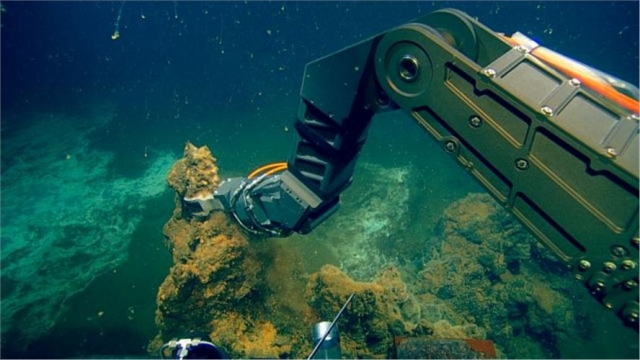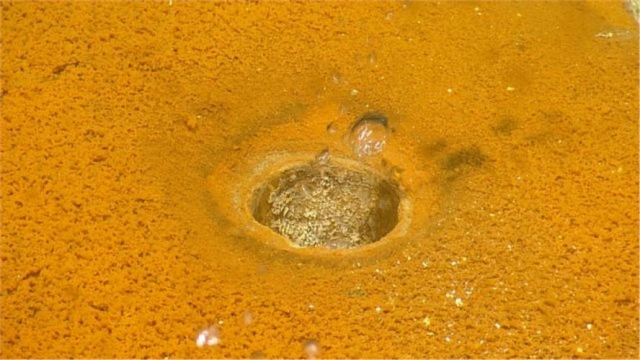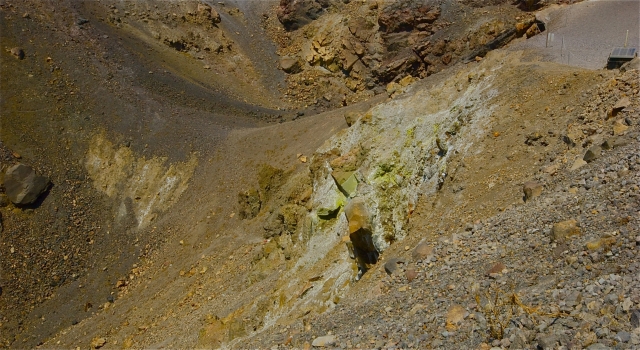Title photo and photos of the volcano in Santorini: Maria S. Topalova
A group of scientists has detected at sea near Santorini surprising quantities of gold and other rare metals such as antimony which are being discharged from the submarine volcano Kolumbo located to the northeast of the island.
The members of the group, researchers from the University of Athens and the Hellenic Centre for Marine Research, had examined the seabed at a depth of 500 metres, establishing at the geothermal field of Kolumbo rare phenomena which have not been observed ever before.
According to Stephanos Kilias, Professor of Economic Geology and head of the group, impressive natural processes are taking place in the magma chamber of the submarine volcano which is five kilometres deep into the crust. These processes are forming elements such as gold, antimony, thallium, silver, arsenic, mercury, zinc and carbon dioxide in impressive quantities. At the same time, the scientists have discovered microorganisms which react in an unusual way and seem to play an important role in the formation of the specific metals and minerals.
"The volcano looks like a cone and its depth is at least 504 metres. There are cracks on the hardened lava on its bottom which discharge carbon dioxide (99%) and some other formations called hydrothermal vents which contain metals such as gold, antimony, silver, thallium," Paraskevi Nomikou, lecturer of geological oceanography, told Ta Nea newspaper.
These vents are in the form of rocky hills dotted with holes. It is worth noting that they have no analogues in the caldera of Santorini. They are located in the north-eastern part of the bottom of the volcano and the highest among them is five metres whereas the widest is 1.5 metres in diameter.
Scientists had been aware of the presence of the vents in 2006 but not of the elements which form them. In 2011 and 2012, members of the Greek research group led by Paraskevi Nomikou who were involved in the oceanographic expedition of the American University in Rhode Island collected rock samples using a submarine robot. In addition, they were able to collect bubbles of gas discharged from the cracks on the bottom of the volcano and samples of hot water.

Initially, the researchers were impressed by the fact that there were no signs of life ten metres above the bottom of the volcano. There were neither small fish nor deep-sea shrimp. They found only a strange microbial ecosystem in bright orange colour mixed with amorphous Fe-oxyhydroxide deposits scattered everywhere. It is already clear that they discharge carbon dioxide bubbles and this actually turns the bottom of Kolumbo into a toxic lake.

The researchers made a complex analysis of the samples from the vents using various methods and equipment at the University of Athens and in some specialized laboratories abroad. Their aim was to determine the chemical composition of the samples, namely the primary, secondary and the trace elements they contain.
The results of the analysis indicate that under the volcano there are deposits of various metals in "rudimentary" stage.
"The analysis showed the presence of gold. The maximum measured value was 32 grams per tonne, and the average value was 9 -10 grams per tonne. The maximum silver concentration in the sample was 1,910 grams per tonne. The concentration of antimony, which is a strategically important metal, was even more impressive. We established a maximum concentration of 22,400 grams per tonne which is 2.2 percent more than the weight. Probably a similar amount has not been reported in international scientific publications," states the head of the group.

The formation of the finding had begun with earthquakes and death. There were a series of earthquakes near Santorini in 1649 and no one could imagine at that time what was happening on the seabed at a distance of 7 kilometres northeast of the island. The earthquakes had gradually "built" the place and the colour of the sea began changing after a strong earthquake a year later (14 September 1650). The seawater changed its colour to green and gas had appeared which killed every living creature in this part of the sea. This was the carbon dioxide produced by the molten magma in the earth's crust and discharged from cracks on the bottom of the volcano. The lava sprung from the sea on 27 September the same year, giving the volcano its present form.

Geologists state that the geodynamic processes in this part of the Aegean Sea are unique. The sinking of the African plate under the European plate near the island of Crete had formed in the region of Santorini two magma chambers – one is in the famous caldera of the island and the other is under the volcano Kolumbo the magma of which discharges the values of metals previously mentioned.
The study of the group involving Greek and foreign researchers is published in Nature magazine: "New sights into hydrothermal vent processes in the unique shallow-submarine arc-volcano, Kolumbo (Santorini), Greece".